Sloane Taylor's Blog, page 20
January 17, 2023
A Taste of Eastern Europe
From Stella May
Borscht is the most famous Ukrainian dish. It is kind of a sour soup common for Eastern Europe. It is low on calories, full of vitamins and minerals, and can be served hot or cold. And you can keep it in your refrigerator for several days. The flavor will only improve. Serve crusty rye bread and butter to complete a terrific dinner or lunch.
There are literally hundreds of different recipes for borscht. Here is my family’s favorite version. I hope you like it too.

BORSCHT1 medium carrot, thinly sliced1 bell pepper, thinly sliced (optional)2 medium potatoes, cut into small cubes1 celery stalk, diced (optional)1 can diced tomatoes, drained5 cups low-sodium chicken broth or vegetable stock3 bay leaves2 tbsp. fresh dill, minced, or 1 tsp. dried2 medium beets, washed, peeled and shredded1 small head cabbage, thinly slicedsalt/ pepper to tastedill for servingsour cream for serving
Arrange the ingredients listed above through the fresh dill into a large pot and bring to a boil.
Reduce the heat, add beets and cabbage. Let simmer until the vegetables are tender. Stir occasionally.
When the soup is almost done, add salt and pepper.
Serve with additional dill and sour cream.
Enjoy!
Here is a little from my latest time travel romance for your reading pleasure.
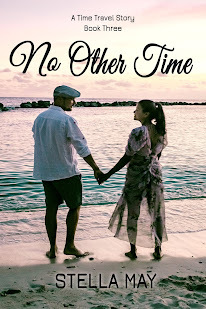
The only way to save their future is risk a journey back to her past.
Time is running out. The message rings in Abby Coleman’s head as clear as the chime of the grandfather clock, her time portal on Amelia Island. Her instincts scream that she must move. Act. But where? And why?
Through she leaped forward a century in time to live an independent life, she reluctantly admits she needs Alex, the insufferable thorn in her side who had the audacity to make her hope. Dream. Yearn.
Alex is through waiting for Abby to come to her senses. And to his complete surprise, the maddening, beautiful woman admits she loves him. Yet to his everlasting frustration, she refuses to marry until she solves her mystery.
In a blinding flash of light, the portal spits out a desperate, heavily pregnant Nika, and the reason becomes all too clear. With Abby missing from her own time, Eli stands accused of her murder. The only way to clear his name is for Abby to go where Alex can’t follow—back through the portal. And one passionate night together may be all they’ll ever have.
 Talented author Stella May is the penname for Marina Sardarova who has a fascinating history you should read on her website.
Talented author Stella May is the penname for Marina Sardarova who has a fascinating history you should read on her website. Stella writes fantasy romance as well as time travel romance. She is the author of 'Till Time Do Us Part, Book 1 in her Upon a Time series, and the stand-alone book Rhapsody in Dreams. Love and family are two cornerstones of her stories and life. Stella’s books are available in e-book and paperback through all major vendors.
When not writing, Stella enjoys classical music, reading, and long walks along the ocean. She lives in Jacksonville, Florida with her husband Leo of 35 years and their son George. They are her two best friends and are all partners in their family business.
Follow Stella on her website and blog Stay connected on Facebook, Twitter, and Pinterest.
January 15, 2023
How Old am I Supposed to Look?
from Anne Montgomery
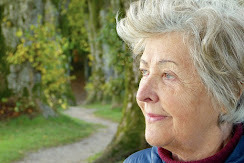
I like to think – in fact, I believe – that in olden times wrinkles signified wisdom and dignity. Today, not so much. Drug makers, who are looking to wipe our faces clean of those evil little lines, are frothing at the mouth to create a product that smooths our skin, an effort to pump up their profits in what is an almost one-billion dollar a year industry.
I became acutely aware of wrinkles as I approached 40. Unbeknownst to me, I was nearing the end of my on-camera sportscasting career, not because I wasn’t good at my job. After all, I’d worked for five TV stations, so, logically, I opined, I must have been a competent reporter. But then, my final contract was not renewed and not a single TV outlet in the country expressed an interest in me, despite my credentials, which included working at both the local and national levels with a stint anchoring SportsCenter at ESPN.
It took me a while to catch on. Glimpses of older on-camera women I’d worked with – especially those framed unforgivingly in HD – more than hinted that they’d had “work” done. Then I’d look in the mirror. Did I really look all that different than when I first took my place in front of the camera?
My answer finally came in rather shocking fashion, a situation caused by years of sports officiating. I began calling amateur games in 1979. I first became a youth ice hockey official, which lead to me being certified in football, baseball, soccer, and basketball. It was those outside sports and silly rules about perception that doomed me. Until relatively recently, sports officials were not allowed to wear sunglasses. In fact, many still eschew regular glasses, as well, opting for contacts, lest they set themselves up for the “What are ya, blind, ump?” retorts that are often flung at sports arbiters.
My loss of vision was gradual, but eventually it was clear something had to be done. Driving at night was difficult, the glare of oncoming headlights excruciating. I couldn’t see those line drives heading my way and would lose passes and kicks in the harsh stadium lights. I had cataracts, sadly, thirty years before the age my parents developed them.
The surgery was quick and simple. I remember thinking the inside of my eyeballs looked like Jackson Pollack paintings, all swirling lines and colors. A day or two later, I stood before the mirror. The haze I’d been looking through for so long had lifted, my sight clear for the first time in years. I reared back. When had all those wrinkles appeared?
It took a while, but I eventually adjusted. I had to admit that my face no longer mattered all that much. Neither my high school students, my beau, nor anyone I cared about gave a whit about whether I had lines on my face. In retrospect, it was rather freeing.
But then one day, while walking by one of those upscale salons in a fancy mall, I was stopped by a pretty twenty-something woman with an alluring accent and flawless skin. She stared at me, tilting her head, long hair cascading about her shoulders.
“Come in! Please.” She smiled, motioning toward the ornate open doors. "Let's take a look at your face.”
As I had a little time to kill, I acquiesced. She put me in a pump-up chair and produced fancy bottles and jars of creams and elixirs guaranteed to make me look younger. Then she handed me that dreaded little round mirror that magnifies to the extreme. I’d like to say I had never succumbed to this particular sales pitch, but I suddenly recalled all those TV years when I thought nothing of dropping two or three hundred bucks on products like the ones she was showing me.
I gazed into the mirror, and then stared up at her. “How old am I supposed to look?”
She paused, tilted her head. “Younger.”
“How much younger?”
She squinted, seemingly puzzled by the question.
“Really? What age am I supposed to look like?”
She pouted, thinking. The smile returned as she dipped the end of her manicured pinky into a blue glass jar. “Younger.”
Then I noticed my long-time beau standing in the doorway of the salon, a bemused look on his face, a man who repeatedly, over two decades, had told me that he doesn’t care if I ever wear makeup or fix my hair or don anything but jeans and T-shirts.
Though she practically implored me to buy some of her magic creams, I declined. As I walked out the door, I couldn’t help but ask her one more time. “How old am I supposed to look?” When she couldn’t answer, I smiled and thanked her. Then Ryan wrapped his arm around my shoulder.
“I love you just the way you are,” he said.
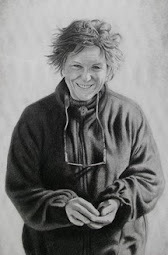
Back when I worked in TV, the condition of my hair and makeup was, sad to say, the most important consideration of my day. Years later, I began dating a lovely man who had an artist draw my portrait. The picture he chose was from a day we’d been out rock collecting in the Arizona desert.
I had found a lovely stone, which I cupped in my hands to show him. No make-up. Hair a wild mess.
“You’re the happiest when you’re rocking,” he said. “This is my favorite picture of you.”
And now, it’s my favorite too.
Allow me to give you a brief intro to my latest women's fiction novel for your reading pleasure.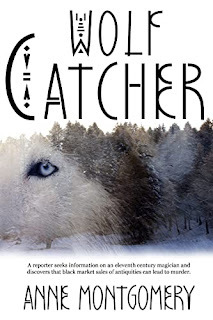
The past and present collide when a tenacious reporter seeks information on an eleventh century magician…and uncovers more than she bargained for.
In 1939, archeologists uncovered a tomb at the Northern Arizona site called Ridge Ruin. The man, bedecked in fine turquoise jewelry and intricate bead work, was surrounded by wooden swords with handles carved into animal hooves and human hands. The Hopi workers stepped back from the grave, knowing what the Moochiwimi sticks meant. This man, buried nine hundred years earlier, was a magician.
Former television journalist Kate Butler hangs on to her investigative reporting career by writing freelance magazine articles. Her research on The Magician shows he bore some European facial characteristics and physical qualities that made him different from the people who buried him. Her quest to discover The Magician’s origin carries her back to a time when the high desert world was shattered by the birth of a volcano and into the present-day dangers of archeological looting where black market sales of antiquities can lead to murder.
Former television journalist Kate Butler hangs on to her investigative reporting career by writing freelance magazine articles. Her research on The Magician shows he bore some European facial characteristics and physical qualities that made him different from the people who buried him. Her quest to discover The Magician’s origin carries her back to a time when the high desert world was shattered by the birth of a volcano and into the present-day dangers of archaeological looting where black market sales of antiquities can lead to murder.
Amazon Buy Link
 Anne Montgomery has worked as a television sportscaster, newspaper and magazine writer, teacher, amateur baseball umpire, and high school football referee. She worked at WRBL‐TV in Columbus, Georgia, WROC‐TV in Rochester, New York, KTSP‐TV in Phoenix, Arizona, ESPN in Bristol, Connecticut, where she anchored the Emmy and ACE award‐winning SportsCenter, and ASPN-TV as the studio host for the NBA’s Phoenix Suns. Montgomery has been a freelance and staff writer for six publications, writing sports, features, movie reviews, and archeological pieces.
Anne Montgomery has worked as a television sportscaster, newspaper and magazine writer, teacher, amateur baseball umpire, and high school football referee. She worked at WRBL‐TV in Columbus, Georgia, WROC‐TV in Rochester, New York, KTSP‐TV in Phoenix, Arizona, ESPN in Bristol, Connecticut, where she anchored the Emmy and ACE award‐winning SportsCenter, and ASPN-TV as the studio host for the NBA’s Phoenix Suns. Montgomery has been a freelance and staff writer for six publications, writing sports, features, movie reviews, and archeological pieces. When she can, Anne indulges in her passions: rock collecting, scuba diving, football refereeing, and playing her guitar.
Learn more about Anne Montgomery on her website and Wikipedia . Stay connected on Facebook , Linkedin , and Twitter .
January 10, 2023
A NOMAD OF SPIRIT
From Linda Lee Greene Author/Artist
As I now firmly inhabit the classification of “senior citizen” there are moments in which my thoughts turn to what my family might inscribe on my tombstone when the time comes. Various labels come to mind, but I wonder how they would also include on that small slab of marble the fact that I am a collector of strays, not of stray animals, but of stray people, people adrift who show up in my orbit seemingly unsolicited. But the truth is that there is nothing random about it, because it is a matter of mutual attraction among kindred spirits—of wandering souls drawn one to the other.
Once upon a time, for a short time, I had a boyfriend who nicknamed me “Gypsy.” I think he might have been the only person in all these years who saw me for who I really am not a globetrotter in the physical sense, but rather a nomad of spirit. It’s a tough thing to go through life knowing that you don’t really fit in anywhere, knowing that you think about and feel things differently than others you encounter along your path. I have never been able to be just “one of the guys (or gals).” Not that I haven’t tried, and in the trying, I became a master quick-change artist: changing my persona to fit in this situation and then changing it again to fit in that situation, ad infinitum. It’s exhausting! There is little doubt that one reason I became an artist, and a writer, is because in those solitary exercises, I breathe a huge sigh of relief and shed the masquerades and be me with only me as companion. An enormous saving grace for me and others like me is social media. Lo and behold, it turns out that there slews and slews of strays the world over with whom I connect on the Internet. Oh, how I wish I could welcome them to my physical neighborhood.
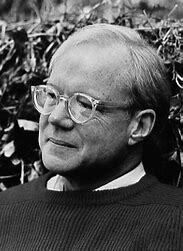
I read a case study in psychotherapist M. Scott Peck’s The Road Less Traveled and Beyond that nailed me. A woman came to him for analysis. Her complaint was just like mine. She was a misfit. “Tell me what I’m doing wrong, please? Please fix me!” she entreated the doctor. Following extensive scrutiny of this patient, Peck finally informed her that there was really nothing the matter with her. He helped her to see that she was different and always would be different, and it was okay—and then they explored ways in which she might find comfort and satisfaction in her differentness, the way I find it in my art and writing, and in my relationships with the strays who have a taste for my world.
I lost my two best strays in the recent past—their last grain of sand fell to the bottom of their hourglass and the Grim Reaper cut them free of physical life with his razor-sharp scythe. Consequently, I’m keeping my door open to the next stray who ambles in. When that day comes, I will sit him/her at my table and ladle up my latest kitchen concoction, a mightily flavorful and easy-to-make soup, Butter & Cheese Celery Soup that makes 4 servings. The recipe is below for your pleasure and as a “thank you” for taking time to read my lonely little confession.

BUTTER & CHEESE CELERY SOUP1 pkg. celery¼ cup bacon bits1 tbsp. grated garlic1 envelope onion soup/dip mix16 oz. vegetable stock1 tbsp. dried thyme1 tbsp. dried parsley flakes1 tbsp. dried chives4 generous shakes coriander powderSea salt and black pepper to taste¾ cup butter¾ cup mozzarella cheese
Chop celery into bitesize pieces, transfer to a colander, wash thoroughly, and then place in Crock Pot, or Slow Cooker, or stove top kettle.
Add bacon bits through salt and pepper. Adjust spices to preferred taste.
Cook until celery chunks are fork soft.
Remove lid and while soup is still hot, stir in butter until it is dissolved. Blend in mozzarella or any other type of grated cheese and stir well to dissolve.
Just before serving, place the soup in a bullet blender or free-standing blender and emulsify it to a creamy consistency.
Leftovers freeze well.
Enjoy!
Linda Lee
Here’s a peek at multi-award-winning author and artist Linda Lee Greene’s latest book, Garden of the Spirits of the Pots, A Spiritual Odyssey. It is a blend of visionary and inspirational fiction with a touch of romance. The story unfolds as ex-pat American Nicholas Plato journeys into parts unknown, both within himself and his adopted home of Sydney, Australia. In the end, the odyssey reveals to him his true purpose for living. The novella is available in eBook and paperback.
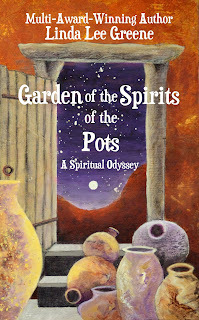
Driven by a deathly thirst, he stops. A strange little brown man materializes out of nowhere and introduces himself merely as ‘Potter,’ and welcomes Nicholas to his ‘Garden of the Spirits of the Pots.’ Although Nicholas has never laid eyes on Potter, the man seems to have expected Nicholas at his bizarre habitation and displays knowledge about him that nobody has any right to possess. Just who is this mysterious Aboriginal potter?
Although they are as mismatched as two persons can be, a strangely inevitable friendship takes hold between them. It is a relationship that can only be directed by an unseen hand bent on setting Nicholas on a mystifying voyage of self-discovery and Potter on revelations of universal certainties.
A blend of visionary and inspirational fiction, and a touch of romance, this is a tale of Nicholas’ journey into parts unknown, both within his adopted home and himself, a quest that in the end leads him to his true purpose for living.
AMAZON BUY LINK
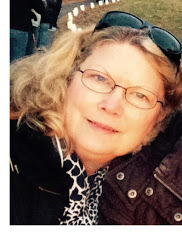
Multi-award-winning author and artist Linda Lee Greene describes her life as a telescope that when trained on her past reveals how each piece of it, whether good or bad or in-between, was necessary in the unfoldment of her fine art and literary paths.
Greene moved from farm-girl to city-girl; dance instructor to wife, mother, and homemaker; divorcee to single-working-mom and adult-college-student; and interior designer to multi-award-winning artist and author, essayist, and blogger. It was decades of challenging life experiences and debilitating, chronic illness that gave birth to her dormant flair for art and writing. Greene was three days shy of her fifty-seventh birthday when her creative spirit took a hold of her.
She found her way to her lonely easel soon thereafter. Since then Greene has accepted commissions and displayed her artwork in shows and galleries in and around the USA. She is also a member of artist and writer associations.
Visit Linda on her blog and join her on Facebook. Linda loves to hear from readers so feel free to email her.
January 8, 2023
Stopping by Woods on a Snowy Evening
from Emma Lane
Robert Frost is one of my favorite poets. At this time of the year his poem Stopping by Woods on a Snowy Evening warms me and makes me long for spring. I hope you enjoy the poem and my short inserts.

Whose woods these are I think I know.
His house is in the village though.
He will not see me stopping here
To watch his woods fill up with snow.
He gives his harness bells a shake
To ask if there is some mistake.
The only other sound’s the sweep
Of easy wind and downy flake.
Acknowledge we all long for warmer weather. In the depths of winter with no hope as yet for spring, we assess the year’s past.
He gives his harness bells a shake
To ask if there is some mistake.
The only other sound’s the sweep
Of easy wind and downy flake.
Take stock. What plan worked; what was a dismal failure.
My little horse must think it queer
To stop without a farmhouse near
Between the woods and frozen lake
The darkest evening of the year.
Taxes loom, but not yet as the spring catalogs have started to arrive. For this household, it’s time to plan, to dream, to make notes, to check budgets. While the snow whirls and the winds blow, the photographs of new varieties of plants sparkle on the brightly colored pages and wish lists grow down the page.
Out my window I see long whips of forsythia, buds protruding, waiting for the first peep of spring breezes. I feel a slight thump of adrenalin race through my veins. Am I already behind on my paperwork? Hard winter, after all, lasts only a few weeks. I finish the last stanza of my favorite poet, Robert Frost. He was an avid nature lover as am I. Best ignore those dark, snowy mornings and get to work. The upcoming warm breezes are sirens of temptation and I’ll want to be outside and doing soon.
The woods are lovely, dark and deep,
But I have promises to keep,
And miles to go before I sleep,
And miles to go before I sleep.
Here's a peek at Emma's winter anthology for your reading pleasure.
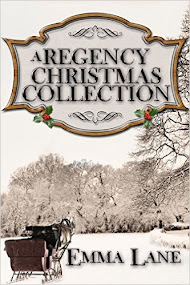 A Wild Wicked Duke
A Wild Wicked Duke After a cruel family betrayal, Caroline Engelson vows the wicked duke will never regain her love unless he first earns her respect, no matter how fervently she longs for his kisses.
A serious accident delivers the wicked duke into Caro’s care, but she is shocked and hurt when he refers to her teen years as the ‘brat with tangled curls.’ Caro is all grown up now when the wicked duke tries to take advantage of her emotions, even as he turns the orderly household into total chaos with his ducal roars. To his astonishment, his best friend’s sister is made of sterner stuff. The situation changes drastically when Caro learns of a shocking family secret.
A Duke Finds Love
Young love is disrupted and the couple parted, but their unsympathetic parents fail to extinguish the strong bond between the two.
Roseland, left pregnant by the duke’s son, weds a neighbor, mistaking that her lover has been forced to marry another. A war and five years later, the two face a second chance, but despite their deep love for one another, impediments must be faced before happily ever after will be theirs at long last.
Beloved Soldier Returns
A wounded British soldier faces amnesia and frustrating dreams but is finally well enough to reclaim his fiancée and his heritage when a gypsy woman arrives to share an important secret.
Robert Cooper-Hanton, a soldier who fought against Napoleon at Waterloo, is seriously wounded and suffers amnesia but survives in a gypsy camp for three years. Pockets of memory are still missing, leaving him with dreams of people with no names, when he makes the decision to begin his journey home. He has no conscious remembrance of a fiancée he left behind but is not surprised to learn that a cousin has usurped his property. When neighborhood friends reveal the fact of his engagement to Lynda Clarington, his memory of her returns in a flash and he recognizes the woman of his dreams.
Lynda had struggled without much success to accept her loss and is overjoyed to learn that Cooper is alive. She has loved him since childhood, but can she adjust to a man who seems irrevocably changed? When a gypsy woman shows up searching for Cooper, Lynda is plagued with doubt. Will Cooper manage to reunite with his old life and the woman he loves, or will he remain lost in his hazy memories, dreams and a changed reality?
Dark Domino
Sarah Louise and Ethan have loved each other all their lives, but a war and time apart may have jeopardized their relationship.
Ethan has been away at war for six long years—without a single letter to the young girl he left behind. He is certain she has forgotten him, but he is still drawn to her. Dressed for a masquerade in a dark domino, he leads her to the garden and tries to steal a kiss. Sarah does not know why the man in the dark domino is so familiar, and why a stranger should give her a feeling of home. When Ethan reveals his identity, Sarah’s anger and hurt overwhelm even her love. Can a new life be built on the foundations of a first love? Or will the Dark Domino remain alone forever?
BUY LINK
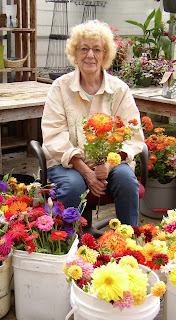
Emma Lane lives in Western New York where winter is snowy, spring arrives with rave reviews, summer days are long and velvet, and fall leaves are riotous color.
Emma is a gifted author who writes under several pennames. She writes Regency Romance as Emma Lane, but also delights in dipping into a Contemporary Cozy Romantic Mystery as Janis Lane.
Her day job is working with flowers at the plant nursery where she is part owner. Look for information about writing and plants on her new website . Leave a comment or a gardening question and put a smile on Emma's face. Stay connected to Emma on Facebook and Twitter .
January 3, 2023
WINTER WARM UP
Some like it hot, some like it cold, some like it in a pot nine days old. Remember the Mother Goose “pease porridge” rhyme? While today we may think of porridge as cereal, in the sixteenth century, “porridge” was a derivation of “pottage” or “potage” meaning cooking pot. “Chowder” also comes from the word pot, via the French “cauldron.”
However you like your soup—hot, cold, or nine days old—combining savory ingredients in a pot and letting the flavors mingle is a time-tested menu favorite.
But what if you want your soup NOW? Well, you’re our kind of person, and we have just the recipe for you. Using already cooked ingredients makes this soup a quick lunch, ready in twenty minutes or less.
Corny Ham Chowder
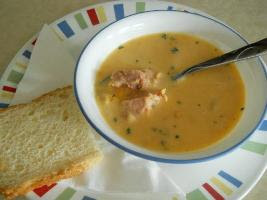 1 cup milk
1 cup milk1 can cream style sweet corn
1½ cups cooked ham, cut into chunks
1½ cups cooked potatoes, drained and cut into chunks (canned works too)
1 tsp. onion powder
1 cup (4 oz) sharp cheddar cheese, shredded
Green onion or scallion slivers (optional)
Salt or chicken bouillon to taste
Mix milk, corn, ham, and potatoes in medium pot. Cook, be sure to stir occasionally until heated through.
Add cheese. Cover pot and let cheese melt completely.
Serve with a chunk of hearty bread.
Bonus Goodness:
Crave added richness? Substitute ½ cup of cream for ½ of the milk.
Are you a vegetable fan? Toss in the veggie of your choice, either frozen or fresh. We like frozen carrots for the added color—and the nutrition too of course.
No ham? Smoked sausage is a nice substitute.
Bland potatoes? Mix in sweet pickle juice. A teaspoon gives the soup zing.
Need more soup? Add more stuff. The converse works too.
Fighting off vampires? Switch out the regular salt for a teaspoon of garlic salt. If you have a bad infestation, add ½ teaspoon crushed garlic to the soup and serve with a wood spoon.
 Once upon a time there was a mother/daughter author dup named Helen and Lorri, who wrote as HL Carpenter. the Carpenters worked from their studios in Carpenter Country, a magical place that, like their stories was unreal but not untrue. Then one day Lorri left her studio to explore the land of What-If, and like others who have lost a loved one the magical place lost much of its magic. But thanks to family, plus an amazing group of wordsmiths named Authors Moving Forward (AMF), the magic is slowly returning.
Once upon a time there was a mother/daughter author dup named Helen and Lorri, who wrote as HL Carpenter. the Carpenters worked from their studios in Carpenter Country, a magical place that, like their stories was unreal but not untrue. Then one day Lorri left her studio to explore the land of What-If, and like others who have lost a loved one the magical place lost much of its magic. But thanks to family, plus an amazing group of wordsmiths named Authors Moving Forward (AMF), the magic is slowly returning.Helen Carpenter loves liking and sharing blog posts from other authors. She lives in Florida with her husband of many years and appreciates every day, especially those without hurricanes.
Stay connected on her blog and Facebook.
January 1, 2023
EACH ONE, TEACH ONE
from Sharon Ledwith
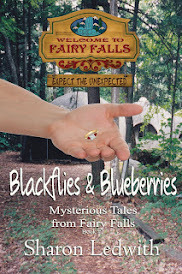
In book two of Mysterious Tales from Fairy Falls, Blackflies and Blueberries, I wrote about Hart Stewart—a teenage psychometrist who has no problem ‘reading’ the absorbed energy from an object like a ring or watch but struggles with the most basic reading skills. He finds a ring that pulls him into the past to witness a woman’s murder that has gone unsolved for over a year. That woman was Diana MacGregor’s mother, and when she discovers that Hart is in possession of the ring and he shares the intimate details of her mother’s murder through his psychic ability, Diana strikes a deal with him. She’ll teach Hart how to read and write if he helps find her mother’s killer.

I’ve had the privilege of being a tutor with the Literacy Council in the northern tourist town where I used to live. It was quite a humbling experience. I was truly amazed how many people fell through the cracks of our society without basic math, reading, and writing skills. I honestly don’t know how they survived, but they found ways to cope, to blend, and to adapt. One of my students had such a backward life, living in the bush with six siblings and parents who did their best with the life tools that they had acquired. He never knew anything different than to buck the system. On welfare, with no skills except as a delivery driver, he managed through life memorizing road signs and maps to keep his job. During one session, I asked him how he had been able to get his driver’s license? He confessed at the time he wrote the test (late 1970s), someone could sit with him and read the test to him. Wow. The times have sure changed! On social assistance for most of his life, he came to the Literacy Council with dreams of getting his A-Z license so that he could drive trucks. A lofty, but attainable goal in his eyes.
So, what are some of the causes of illiteracy?
Problems are almost always a result of difficulties in the early school years, prior to grade four. Some reasons for falling through the cracks are:
1. The high mobility of our society (family moving around) and the fact that school curricula are not standardized from school board to school board.
2.Child immaturity (not interested in learning) compounded by lack of parental involvement with early education.
3.Intellectual limitations.
4.Teachers are overburdened by large classrooms and integrated special needs, as well as lack of time, opportunity and resources.
5. Generational illiteracy—illiterate or non-English speaking parents at home—no books, no role model, reading has no importance.
6.Undiagnosed visual or hearing impairment or learning disability.
7.Trauma—lengthy illness, death of a close loved one, parent’s divorce, etc.
In some cases, the bleak future (dead-end, low-paying jobs, frequent unemployment, utter dependence on others) causes anger, frustration and hopelessness, which in turn often leads to violence and crime. Today, in the jail system, studies are revealing the reading level of the average inmate to be at grade two. I’m not sure if my student ever did achieve his goals as a truck driver, but hopefully I gave him some basic skills that would serve him for the rest of his life. Each one, teach one starts in the home by doing something as simple as reading to your child at bedtime. And if you ever get a chance to volunteer at your local literacy council, take a chance and change a life! You’ll be glad you made a difference.
Here's a snippet of my latest novel, Blackflies and Blueberries, the second installment of Mysterious Tales from Falls teen psychic mystery series…
The only witness left to testify against an unsolved crime in Fairy Falls isn’t a person…
City born and bred, Hart Stewart possesses the gift of psychometry—the psychic ability to discover facts about an event or person by touching inanimate objects associated with them. Since his mother’s death, seventeen-year-old Hart has endured homelessness, and has learned ways to keep his illiteracy under wraps. He eventually learns of a great-aunt living in Fairy Falls and decides to leave the only life he’s ever known for an uncertain future.
Diana MacGregor lives in Fairy Falls. Her mother was a victim of a senseless murder. Only Diana’s unanswered questions and her grief keeps her going, until Hart finds her mother’s lost ring and becomes a witness to her murder.
Through Hart’s psychic power, Diana gains hope for justice. Their investigation leads them into the corrupt world threatening Fairy Falls. To secure the town’s future, Hart and Diana must join forces to uncover the shocking truth, or they risk losing the true essence of Fairy Falls forever.
Here’s a glimpse of the premises of both my young adult series.
The Last Timekeepers Time Travel Adventures
Chosen by an Atlantean Magus to be Timekeepers—legendary time travelers sworn to keep history safe from the evil Belial—five classmates are sent into the past to restore balance, and bring order back into the world, one mission at a time.
Children are the keys to our future. And now, children are the only hope for our past.
Mysterious Tales from Fairy Falls Teen Psychic Mysteries
Imagine a teenager possessing a psychic ability and struggling to cope with its freakish power. There’s no hope for a normal life, and no one who understands. Now, imagine being uprooted and forced to live in a small tourist town where nothing much ever happens. It’s bores-ville from the get-go. Until mysterious things start to happen.
Welcome to Fairy Falls. Expect the unexpected.
The Last Timekeepers Time Travel Adventure Series:
The Last Timekeepers and the Noble Slave, Book #3
MIRROR WORLD PUBLISHING׀ AMAZON ׀ BARNES & NOBLE ׀
The Last Timekeepers and the Dark Secret, Book #2 Buy Links:
MIRROR WORLD PUBLISHING׀ AMAZON ׀ BARNES & NOBLE ׀
The Last Timekeepers and the Arch of Atlantis, Book #1 Buy Links:
MIRROR WORLD PUBLISHING׀ AMAZON ׀ BARNES & NOBLE ׀
Legend of the Timekeepers, prequel Buy Links:
MIRROR WORLD PUBLISHING ׀ AMAZON ׀ BARNES & NOBLE׀
Mysterious Tales from Fairy Falls Teen Psychic Mystery Series:
Lost and Found, Book One Buy Links:
MIRROR WORLD PUBLISHING ׀ AMAZON ׀ BARNES & NOBLE׀
Blackflies and Blueberries, Book Two Buy Links:
MIRROR WORLD PUBLISHING ׀ AMAZON ׀ BARNES & NOBLE׀
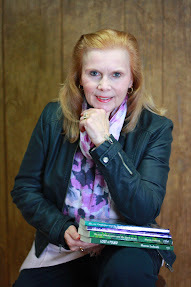
Sharon Ledwith is the author of the middle-grade/young adult time travel adventure series, THE LAST TIMEKEEPERS, and the award-winning teen psychic mystery series, MYSTERIOUS TALES FROM FAIRY FALLS. When not writing, reading, researching, or revising, she enjoys anything arcane, ancient mysteries, and single malt scotch. Sharon lives a serene, yet busy life in a southern tourist region of Ontario, Canada, with her spoiled hubby, and a moody calico cat.
Learn more about Sharon Ledwith on her WEBSITE and BLOG. Look up her AMAZON AUTHORpage for a list of current books. Stay connected on FACEBOOK, TWITTER, PINTEREST, LINKEDIN, INSTAGRAM, and GOODREADS.
BONUS: Download the free PDF short story The Terrible, Mighty Crystal HERE
December 25, 2022
To all our Australian, Canadian, and British friends,Hap...
December 18, 2022
THE GIFT
From Linda Lee Greene, Author/Artist
The one-room, Cedar Fork schoolhouse across the holler from the little log cabin on the near side of Peach Mountain was a tolerable two-mile walk-in good weather. It was an enjoyable walk actually, if one had time to swing from a grapevine on top of a high cliff and drop into Cedar Fork Creek for a lazy dip or stop by the Workman’s place for a quick smoke of their cornsilk tobacco. But in snowdrifts as tall as thirteen-year-old, Lee Greene, in threadbare clothes, thin hand-me-down coat, and barely covered feet in holey socks flopping in an old pair of secondhand shoes that were several sizes too big for him, the walk that frigid morning was worse than pure misery.
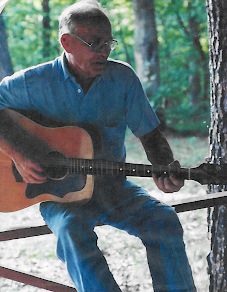
Lee’s chronically aching stomach was hollow and rumbling. His meager breakfast of cornmeal mush and sugar water was quickly wearing thin, but he had more important things than his stomach to worry about that morning. He was stewing about the paucity of milk he had drawn from his family’s cow tethered in the yard just beyond the lean-to kitchen at the back of their tiny log cabin. The two-story structure, built by Lee, his older brother, Bill and their father only five months before, comprised a common, or front room, on the main level, a primitive lean-to kitchen at the back, and a bedroom where his parents slept. The room housed the only closet in the place. A rough-hewn timber ladder gained access to the upper deck, where, in an open-to-the-front loft, all the many children slept on crude cots, or thin pads on the floor. A large ceiling-to-floor fireplace of indigenous stones in the common room on the first floor was the only source of heat in the place. Felled tree trunks supporting its roof, a porch spanned the width of the front of the log cabin.
The soil on Cedar Fork, thin, hard, and dry, a crusty layer of sediment topping a bedrock of limestone, dolomite and shale, made for poor farming and gardening, posing a formidable challenge for growing adequate crops. Squirrels, rabbits, opossums and birds, hunted and brought in by Lee and Bill, the insufficient supply of milk from the cow, and scant eggs supplied by their paltry flock of scrawny chickens in the yard, were the only sources of protein for the family. In season, a large vegetable garden and a stand of corn were coddled into fruition in the poor soil, but only if they were favored with enough rain.
His nose and eyes crusty from yet another head cold, gloveless hands thrust into the pockets of his thin coat, and his feet turning to blocks of ice, Lee trudged on to school, his white-blond head under his hat hunkered into his shoulders. Despite the fact that he might not make it through the perpetual hardships of his life, much less that cold, windy, and snowbound morning, his soul was full of dreams, his mind of intention, his body of vigor and endurance, and on the strength of pure power of will alone, and maybe some help from the man upstairs, Lee was determined that if he got out of his childhood alive, nothing would ever encumber him again.
The schoolhouse was dark and frigid, and Lee, by design, was the first student to arrive. The door was unlocked as it always was, and Lee, halting for a few minutes to give his blood a chance to circulate again in his frozen limbs and digits, sat down on one of the benches. He would have wept if he had allowed himself to seriously consider his unfortunate circumstances—but not Lee! No, not Lee! Not the boy/man who five years in the future would be my father. He had a chance to earn fifty cents that week, and every week for weeks to come, fifty cents for building a fire in the “Warm Morning” coal-burning, heating-stove each morning before school, and that was exactly what he was going to do.”
***
“Life is difficult,” renowned psychotherapist, M. Scott Peck states in his groundbreaking book, The Road Less Traveled. The above excerpt from Guardians and Other Angles, my novel that is based on the true story of my grandparents and parents and their immediate families illustrates that my father’s early life was a testament to Peck’s pronouncement. Born in the midst of the Great Depression, my dad was the third of twelve children. Few were the hours, or even minutes, of every day that were not devoted to details of survival: scouring for food, maintaining shelter, searching for work of any kind. Like millions of others among the “Greatest Generation,” the extreme difficulties of the times forced my father to grow up on his own, primarily. Through the perils and pitfalls of life as he encountered it, he survived and thrived, and in the process evolved into perhaps the most disciplined person I have ever known. Don’t get me wrong—my dad was a fun guy. Sharing a beer or fishing with a buddy or two was high on his agenda; he was a shark at Euchre; he knew a million jokes and delivered them like a pro; he played the guitar and sang with the best of them. But getting the job done always came before pleasure. Peck calls it “delaying gratification,” which is one of the essential tools in the development and maintenance of discipline. Growth absent a consistent basis of discipline sputters and then stalls sooner or later.
My father gave me many priceless gifts during his lifetime, legacies that have endured these many years since his passing. One of the greatest of them was his talent for discipline. I am not as good at it as he was, but I will die trying.
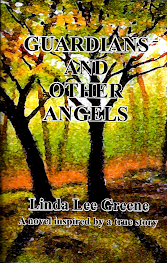
Guardians and Other Angels, multi-award-winning author Linda Lee Greene's novel, chronicles the story of two heroic families played out against the bad and the good of the early to mid-twentieth century, years of worldwide economic depression and war, as well as the spawning of the “Greatest Generation.” Firsthand accounts of the times in authentic letters written by members of the families are peppered throughout the book. Available in paperback and in eBook on Amazon

Multi-award-winning author and artist Linda Lee Greene describes her life as a telescope that when trained on her past reveals how each piece of it, whether good or bad or in-between, was necessary in the unfoldment of her fine art and literary paths.
Greene moved from farm-girl to city-girl; dance instructor to wife, mother, and homemaker; divorcee to single-working-mom and adult-college-student; and interior designer to multi-award-winning artist and author, essayist, and blogger. It was decades of challenging life experiences and debilitating, chronic illness that gave birth to her dormant flair for art and writing. Greene was three days shy of her fifty-seventh birthday when her creative spirit took a hold of her.
She found her way to her lonely easel soon thereafter. Since then Greene has accepted commissions and displayed her artwork in shows and galleries in and around the USA. She is also a member of artist and writer associations.
Visit Linda on her blog and join her on Facebook. Linda loves to hear from readers so feel free to email her.
December 13, 2022
EASY CHRISTMAS BRUNCH
After we entertain Christmas Eve, we tear through the house cleaning up before the kids and grands come for brunch Christmas Day. This meal is wonderful because so much can be prepared well in advance and stored in the fridge until it’s time to cook.
MENU Breakfast Soufflé Hash Browns Fresh Fruit Salad Mini Croissants Christmas Cookies & Leftover Desserts Mimosas Breakfast Soufflé 1 lb. (½kg) ham, bacon, or breakfast sausage 9 eggs, lightly beaten 3 cups (750ml) milk 1 tsp. (5ml) dry mustard Diced green, red, and/or yellow pepper to taste ½ lb. (57g) sharp cheddar cheese, grated ½ lb. (57g) Swiss or Gruyere cheese, or a combination of the two, grated Diced onion to taste Freshly ground black pepper to taste 4 – 1 in. (2.54cm) slices Vienna or French bread, cubed
Breakfast Soufflé 1 lb. (½kg) ham, bacon, or breakfast sausage 9 eggs, lightly beaten 3 cups (750ml) milk 1 tsp. (5ml) dry mustard Diced green, red, and/or yellow pepper to taste ½ lb. (57g) sharp cheddar cheese, grated ½ lb. (57g) Swiss or Gruyere cheese, or a combination of the two, grated Diced onion to taste Freshly ground black pepper to taste 4 – 1 in. (2.54cm) slices Vienna or French bread, cubed Preheat oven to 350°F (180°C).
Dice ham or bacon. If you use ham, set aside in the bowl you use for the eggs. Fry bacon to the crispness you prefer. Drain on paper towels. If you use breakfast sausage, fry meat until no longer pink. Be sure to break up any clumps. Drain meat in a colander while you continue to prepare the soufflé.
Add all ingredients, except bread, to eggs. Stir well. Gently stir in bread.
Pour mixture into an ungreased 9 x 13-inch (33 x 22cm) glass baking dish. Bake 1 hour or until a knife inserted in the center has no egg clinging to it.
This dish can be assembled one or two days ahead of time. On serving day allow the soufflé to sit on your counter 1 – 2 hours before you bake it.
Leftovers are excellent from the microwave.
Hash Browns If you need to increase the hash browns recipe for a larger group of people, it’s best to sparingly add more garlic powder. As is this recipe serves 6. Leftovers reheat beautifully.
3 russet potatoes (about 1½ pounds), peeled 1½ tsp. (7.5ml) garlic powder, not salt Freshly ground pepper, to taste ¼ cup (60ml) extra virgin olive oil
Shred potatoes on the large holes of a box grater or use the coarse grater disk on a food processor. Transfer them to a bowl of cold water. Allow them to soak for 2 minutes. Drain in a colander and then rinse under cold water. You do this to remove the starch that makes hash browns gummy.
Transfer shreds to a kitchen towel. Gather together ends of towel and twist over sink, squeezing firmly to wring out as much liquid as possible. This step creates crisp hash browns. Transfer potatoes to a medium bowl and toss with garlic powder and pepper. Be sure to evenly distribute the seasonings.
Heat olive oil in a large skillet over medium heat. Add potatoes, press down to form a thin layer and cook for a minute or two. Stir and then press down again. Cook until a dark golden crust forms, about 5 minutes.
Turn potatoes in sections. This is easier than trying to turn the food as a whole. Continue to fry until hash browns are crisp and browned all over, 5 minutes or so. Transfer to paper towels to absorb excess oil.
Fresh Fruit Salad 1 banana, peeled 1 pear, cored 1 tbsp. (15ml) lemon juice ¼ pineapple, peeled, cored, and diced 1 kiwi, peeled and sliced 10 seedless red grapes, halved 10 blueberries 10 raspberries, optional
Slice banana into bitesize pieces. Scoop into a medium-sized bowl. Dice pear and add to bowl. Sprinkle lemon juice over fruit to stop it from turning brown and mix well.
Gently fold in remaining fruit.
Spoon into a glass bowl, cover with cling wrap, and chill until time to serve. Leftovers are still good the next day.
Mimosas 1 bottle sparking white wine or champagne, cold 1 carton orange juice, cold Tall slender glasses
Fill glasses half full with wine. Tip the glass slightly as you pour to retain the fizz. Top off with orange juice. Don’t stir. That will destroy the bubbles.
May you enjoy all the days of your life filled with good friends, laughter, and seated around a well-laden table!
Sloane
December 11, 2022
WHEN MY LIFE PASSES
I will see dolphins.
from Anne Montgomery
The expression “I saw my life pass before my eyes,” is generally used by someone who has had a near-death experience. While I have no idea what may occur when the end nears, I have always liked that thought, as long as one only has to recall the pleasant events.

Once, off St. Kitts, I witnessed four tiny juvenile drum fish dancing in a row before a reef
Sometimes, I consider scenes that might appear in my head when my time comes, and I find it is a rather Forrest Gump-esque list: The night at Girl Scout camp on an island in Upstate New York, snuggled in my sleeping bag, a cool breeze wafting through the pines, lake water brushing up against the rocks. An elk in Colorado, maybe ten yards between us, his majestic antlered head and dark brown eyes freezing me in place, before he turned and disappeared silently into the forest. A dive in St. Kitts where I witnessed four tiny spotted drum fish, each no bigger than a thumbnail, long black-and-white fins waving as they danced in a row before a reef.
And now, I have a new vision to carry with me. A few days ago, in the sea off the north shore of St. Croix, we spotted three bottlenose dolphins from our dive boat. We quickly donned our scuba gear and descended to a shallow area white with sand. We knelt on the bottom and waited.
And waited.
Thirty minutes later, chilled from inactivity, we gave up, and swam away, perusing a group of coral heads down over the edge of the sand. Cold and tired we headed back toward the boat. The dive master, E.T., and I were the last in the water. We waited below the boat as other divers ascended.
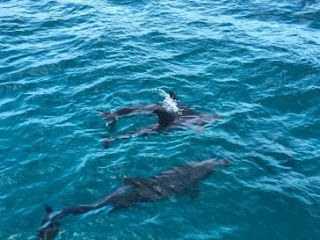
While diving in St. Croix we spotted three bottlenose dolphins from our boat, so we donned our scuba gear and dropped in to join them.
Then, E.T. grunted to get my attention. She pointed at three dolphins that swam directly toward us, their snouts dipping with each gentle push of their tails. The largest, a female perhaps eight-feet long, silvery-gray with a white belly, was escorted by two smaller males. The female eyed me and guided the others over my head. I could have reached up and touched her as they glided past. Then, she dove to the bottom and stuck her nose in the sand. She stirred up a white cloud, rolled onto her back and lay on the bottom, while the males playfully nudged her. Soon, she twisted, launched herself off the sand, and they disappeared.
We waited. And they returned, over and over playing before us. Then, the female stopped, touched her tail to the sand and straightened. I had always thought of dolphins as curved creatures, but she now stood perfectly straight, snout pointed toward the sky, fins out, a signal perhaps to the males who approached and straightened as well, clinging to her sides, motionless.
They appeared as a marble statue, majestic, magical, holding the pose above the sand, her bearing that of an empress. Then she twirled and the males followed. What came next can only be described in one way: dolphin sex. I felt like a voyeur but could not turn away. I will let you fill in the rest.
At one point, overwhelmed by the beauty, this gift I’d been given by the sea, I touched my hand to my heart. When I gazed at E.T., she had done the same. We stared at one another, knowing we had shared something special.
When we finally ascended, I was speechless. Those who know me would be astounded at the idea. And I am still unsure my words here do the experience justice.
I hugged the dive master, a woman I had met just a few hours earlier.
“E.T., when I’m dying, I will remember this,” I said.
It was only then that I noticed the elegant tattoo she bore on her right hip: a dolphin.
The view my dolphin video click here.
Allow me to give you a brief intro to my latest women's fiction novel for your reading pleasure.

The past and present collide when a tenacious reporter seeks information on an eleventh century magician…and uncovers more than she bargained for.
In 1939, archeologists uncovered a tomb at the Northern Arizona site called Ridge Ruin. The man, bedecked in fine turquoise jewelry and intricate bead work, was surrounded by wooden swords with handles carved into animal hooves and human hands. The Hopi workers stepped back from the grave, knowing what the Moochiwimi sticks meant. This man, buried nine hundred years earlier, was a magician.
Former television journalist Kate Butler hangs on to her investigative reporting career by writing freelance magazine articles. Her research on The Magician shows he bore some European facial characteristics and physical qualities that made him different from the people who buried him. Her quest to discover The Magician’s origin carries her back to a time when the high desert world was shattered by the birth of a volcano and into the present-day dangers of archeological looting where black market sales of antiquities can lead to murder.
Former television journalist Kate Butler hangs on to her investigative reporting career by writing freelance magazine articles. Her research on The Magician shows he bore some European facial characteristics and physical qualities that made him different from the people who buried him. Her quest to discover The Magician’s origin carries her back to a time when the high desert world was shattered by the birth of a volcano and into the present-day dangers of archaeological looting where black market sales of antiquities can lead to murder.
Amazon Buy Link
 Anne Montgomery has worked as a television sportscaster, newspaper and magazine writer, teacher, amateur baseball umpire, and high school football referee. She worked at WRBL‐TV in Columbus, Georgia, WROC‐TV in Rochester, New York, KTSP‐TV in Phoenix, Arizona, ESPN in Bristol, Connecticut, where she anchored the Emmy and ACE award‐winning SportsCenter, and ASPN-TV as the studio host for the NBA’s Phoenix Suns. Montgomery has been a freelance and staff writer for six publications, writing sports, features, movie reviews, and archeological pieces.
Anne Montgomery has worked as a television sportscaster, newspaper and magazine writer, teacher, amateur baseball umpire, and high school football referee. She worked at WRBL‐TV in Columbus, Georgia, WROC‐TV in Rochester, New York, KTSP‐TV in Phoenix, Arizona, ESPN in Bristol, Connecticut, where she anchored the Emmy and ACE award‐winning SportsCenter, and ASPN-TV as the studio host for the NBA’s Phoenix Suns. Montgomery has been a freelance and staff writer for six publications, writing sports, features, movie reviews, and archeological pieces. When she can, Anne indulges in her passions: rock collecting, scuba diving, football refereeing, and playing her guitar.
Learn more about Anne Montgomery on her website and Wikipedia . Stay connected on Facebook , Linkedin , and Twitter .




